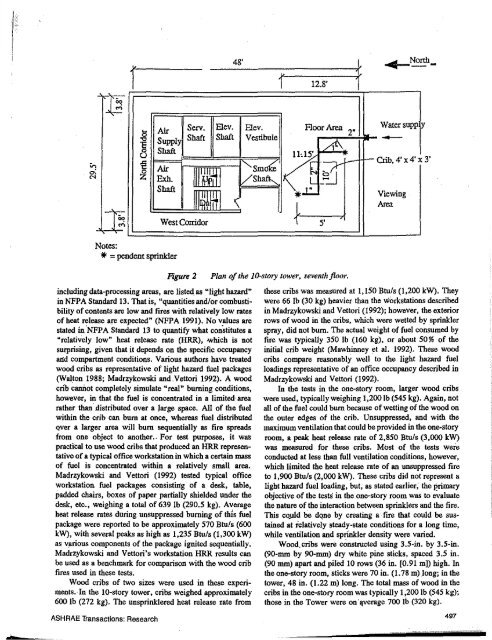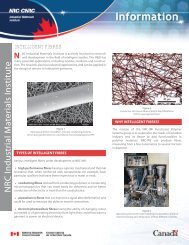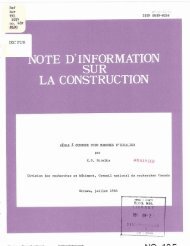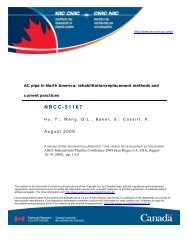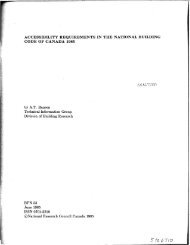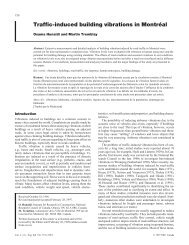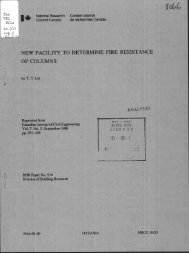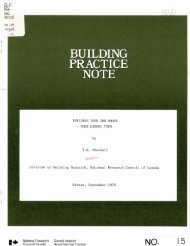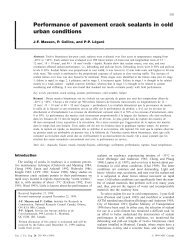Effect of Automatic Sprinkler Protection on Smoke Control Systems
Effect of Automatic Sprinkler Protection on Smoke Control Systems
Effect of Automatic Sprinkler Protection on Smoke Control Systems
Create successful ePaper yourself
Turn your PDF publications into a flip-book with our unique Google optimized e-Paper software.
hI'J]48'i'12.8'Air Serv. Eev. Eev. Floor Area • Watersupp y!5 2"0 Shaft ShaftSupplyVestibule·suShaftI Air mJ"sm~~(~ .,;,-Exh. /Sh~ L~_jShaft:l*.!:.11-.1~ ~.-Crib, 4' X 4' X 3'Viewing1-->r,-: \ LArea00West COII:idor 1 5'"'Notes:* = pendent sprinklerFigure 2including data-processing areas, are listed. as "light hazard"in NFPA Standard 13. That is, "quantities and/or combustibility<str<strong>on</strong>g>of</str<strong>on</strong>g> c<strong>on</strong>tents are low and fires with relatively low rates<str<strong>on</strong>g>of</str<strong>on</strong>g> heat release are expected" (NFPA 1991). No values arestated in .NFPA Standard 13 to quantify what c<strong>on</strong>stitutes a"relatively low" heat release rate (HRR), ·which is notsurprising, given that it depends <strong>on</strong> the specific occupancyarld compartment c<strong>on</strong>diti<strong>on</strong>s. Various authors have treatedwood cribs as representative <str<strong>on</strong>g>of</str<strong>on</strong>g> light hazard fuel packages(Walt<strong>on</strong> 1988; Madrzykowski and .Vettori 1992). A woodcrib canilot completely simulate "real" burning c<strong>on</strong>diti<strong>on</strong>s,however, in that the fuel is c<strong>on</strong>centrated in a limited· arearather than· distributed over a large space. All <str<strong>on</strong>g>of</str<strong>on</strong>g> the fuelwithin the crib can bum at <strong>on</strong>ce, whereas fuel distributedQver a larger area will bum sequentially as fire spreadsfrom <strong>on</strong>e object to another .. For test purposes, it waspractical to use wood cribs that produced an HRR representative<str<strong>on</strong>g>of</str<strong>on</strong>g> a typical <str<strong>on</strong>g>of</str<strong>on</strong>g>fice workstati<strong>on</strong> in which a certain mass<str<strong>on</strong>g>of</str<strong>on</strong>g> fuel is c<strong>on</strong>centrated within a relatively small area.Madrzykowski and Vettori (1992) tested typical <str<strong>on</strong>g>of</str<strong>on</strong>g>ficeworkstati<strong>on</strong> fuel packages c<strong>on</strong>sisting <str<strong>on</strong>g>of</str<strong>on</strong>g> a desk, table,padded chairs, boxes <str<strong>on</strong>g>of</str<strong>on</strong>g> paper partially shielded under thedesk, etc., weighing a total <str<strong>on</strong>g>of</str<strong>on</strong>g> 639 Jb (290.5 kg). Averageheat release rates during unsuppressed burning <str<strong>on</strong>g>of</str<strong>on</strong>g> this fuelpackage were reported to be approximately 570 Btu/s (600kW), with several peaks as high as 1,235 Btu/s (1,300 kW)as various comp<strong>on</strong>ents <str<strong>on</strong>g>of</str<strong>on</strong>g> the package ignited sequentially.Madrzykowski and Vettori's workstati<strong>on</strong> HRR results canbe used as a benchmark for comparis<strong>on</strong> with the wood cribfires used in these tests.Wood cribs <str<strong>on</strong>g>of</str<strong>on</strong>g> two sizes were used in these experiments.·In the 10-story tower, cribs weighed approximately600 Jb (272 kg). The unsprinklered heat release rate fromPlan <str<strong>on</strong>g>of</str<strong>on</strong>g> the J().story tower, seventh floor.these cribs was measured at 1,150 Btu/s (1,200 kW). Theywere 66 lb (30 kg) heavier than the workstati<strong>on</strong>s describedin Madrzykowski and Vettori (1992); however, the exteriorrows <str<strong>on</strong>g>of</str<strong>on</strong>g> wood in the cribs, which were wetted by sprinklerspray, did not bum. The actual weight <str<strong>on</strong>g>of</str<strong>on</strong>g> fuel c<strong>on</strong>sumed byfire was typically 350 Jb (160 kg), or about 50% <str<strong>on</strong>g>of</str<strong>on</strong>g> theinitial crib weight (Mawhinney et al. 1992). These woodcribs compare reas<strong>on</strong>ably well to the light hazard fuelloadings representative <str<strong>on</strong>g>of</str<strong>on</strong>g> an <str<strong>on</strong>g>of</str<strong>on</strong>g>fice occupancy described inMadrzykowski and Vettori (1992).In the tests in the <strong>on</strong>e-story room, larger wood cribswere used, typically weighing 1,200 Jb (545 kg). Again, notall <str<strong>on</strong>g>of</str<strong>on</strong>g> the fuel could bum because <str<strong>on</strong>g>of</str<strong>on</strong>g> wetting <str<strong>on</strong>g>of</str<strong>on</strong>g> the wood <strong>on</strong>the outer edges <str<strong>on</strong>g>of</str<strong>on</strong>g> the crib. Unsuppressed, and with themaximum ventilati<strong>on</strong> that could be provided in the <strong>on</strong>e-storyroom, a peak heat release rate <str<strong>on</strong>g>of</str<strong>on</strong>g> 2,850 Btu/s (3,000 kW)was measured for these cribs. Most <str<strong>on</strong>g>of</str<strong>on</strong>g> the tests werec<strong>on</strong>ducted at Jess than full ventilati<strong>on</strong> c<strong>on</strong>diti<strong>on</strong>s, however,which limited the heat release rate <str<strong>on</strong>g>of</str<strong>on</strong>g> an unsuppressed fireto 1,900 Btu/s (2,000 kW). These cribs did not represent alight hazard fuel loading, but, as stated earlier; the P.rimaryobjective <str<strong>on</strong>g>of</str<strong>on</strong>g> the testS in the <strong>on</strong>e-story room was to evaluatethe nature <str<strong>on</strong>g>of</str<strong>on</strong>g> the interacti<strong>on</strong> between sprinklers and the fire.This co.uld be dqne by creating a fire that could be sus·tained at relatively steady-state c<strong>on</strong>diti<strong>on</strong>s for a l<strong>on</strong>g time,while ventilati<strong>on</strong> and sprinkler density were varied.Wood. cribs were c<strong>on</strong>structed using 3.5-in. by 3.5-in.(90-mm by 90-mm) dry white pine sticks, spaced 3.5 in.(90 mm) apart and piled 10 rows (36 in. [0.91 m]) high. Inthe <strong>on</strong>e-story room, sticks were 70 in. (1.78 m) .l<strong>on</strong>g; in thetower, 48 in. (1.22 m) l<strong>on</strong>g. The total mass <str<strong>on</strong>g>of</str<strong>on</strong>g> wood in thecribs in the <strong>on</strong>e-story room was typically 1,200 lb (545 kg);those in the Tower were <strong>on</strong>·~verage 700 Ib (320 kg).ASH RAE Transacti<strong>on</strong>s: Research497


